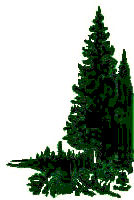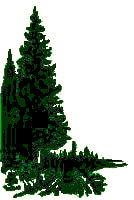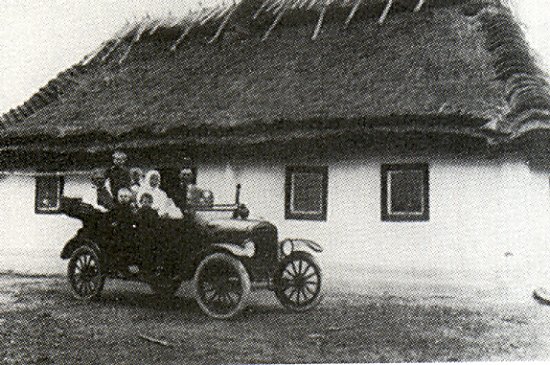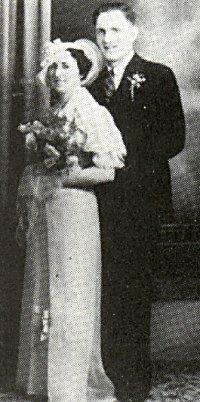



Bruce and Edna Scorgie.
Bruce and Edna Scorgie came to the rapid Bend district in 1935. They came up by team and wagon and for the first while they stayed with the Davidson family. Like many other settlers in the thirties, they moved north to establish a new home. In 1936, Mr and Mrs Scorgie purchased a homestead. They built a home and moved onto their land. They were without any livestock and had only thirty-five cents cash, along with their garden. During this same year, Bruce went fighting fires at Dog lake and Hackett Lake, receiving one dollar per day for his labour. Edna was left alone on the homestead while her husband was away. The Scorgies managed to clear ten acres of land by hand and team during the summer. They would hook a chain to the tip of the tree and then the team would pull it down. Working in the field posed quite a problem to both the farmer and his team. Mosquitoes would cover the horses since the muskeg provided a more than suitable environment. Bruce would light a smudge in a pail and tie it between the horses to offer them some relief from the mosquitoes and flies. Bruce and Edna were allowed seven dollars and thirty cents per month for relief, and Bruce had to pay it back by working on the road construction gangs for one dollar a day. Bruce also trapped during the winter months around his home which helped supplement the family's income. Also, Bruce would make use of the wild game to provide his family with food. Edna would smoke moose meat and this would be the replacement of bacon. In 1940, Bruce joined the army. The relief money was increased from seven dollars and thirty cents to seventy-nine dollars, as a result of Bruce signing up for the war. With this money, Edna purchased a cow and dug a well. Bruce was in the army for nine months and when he returned home he was towerman at Neslin Lake for two months. During this time, a fire was spotted and within one night it travelled a distance of twelve miles. The fire was finally slowed down as a result of a June snowfall. During all of this time, Mrs Scorgie stayed alone on the homestead. She had purchased three ewes and increased the herd to sixty-five. When the crop froze she knew that she could always count on the money obtained when the lambs were sold. Edna learned to spin wool, and knit. She would also pick blueberries, make butter and sell it to make some money. Mr. and Mrs, Scorgie had two children: Audrey and Leslie. They moved into Big River in 1970, with Leslie taking over the homestead. Bruce now works at the Big River Sawmill and still does some trapping.
Mike and Hafia Shinkaruk
Submitted by Mrs. V. Zinovich. Mike and Hafia Shinkaruk moved from Wakaw to a homestead in the Sleepy Hollow district in approximately 1940. Their youngest daughter, Muriel and youngest son, John were still at home. Mike and the neighbours built a school which is the present Evangelical Church of Big River. Muriel and John were taught by Mrs Burt. The Shenkaruks stayed in the Sleepy Hollow district for only about five years because the land was too low to produce a successful crop. They moved to Prince Albert where mike retired. Mike and Hafia had twelve children, they were: Mary, Bill, Anne, Nettie, Dorothy, Alexandra (Zinovich), Harry, Peter, Olga, Lena, Muriel, and John. 
Mr. and Mrs. Shinkaruk and family
at their home in Wakaw.
Mr. and Mrs. Wasal Skopyk.
In 1939, Mr and Mrs Skopyk moved north from St. Julian, Saskatchewan, to the Greenmantle district to homestead. They built their first home, a log cabin, and settled down to make their farm a self-supporting operation. The Skopyk family had a small shingle and sawmill. They owned a tractor and therefore they could open up land more easily than other settlers. They also had their own bees which provided honey for the household. In later years, they were able to build a new home and a large barn for their livestock. Mr. and Mrs Skopyk had four children: Alec (living in Meadow lake), Ann (living in Big River). Mike purchased the Blacksmith shop in the spring of 1952. He still operates this business in Big River.
Joe and Rena Sixsmith.

Joe Sixsmith came to Canada from Ireland in 1926. He joined the RCMP at Regina in 1929 and had six months training before being posted at Prince Albert. On April 8, 1931, Joe was transferred to Big River to open a Detachment. Joe married Miss Rena Clarkson in 1936. The new RCMP Office was in a medium-size bungalow directly across the street from the present-day Anglican Church. There was no electricity or water and a wood stove was for heat and cooking. Joe remembers when the Detachment got its phone in 1931. It was listed in the directory as number nine, that being the total number of phones in Big River at the time. Joe Policed the village and the largely rural area. The area covered the Big River Indian Reserve, Shell River, Debden, Stump Lake, Park Valley, and as far north as Dore lake. A graded dirt road came as far as Dumble from Prince Albert and the remaining fifteen miles was a winding trail. During this time, many trails led out of the surrounding district through bush and meadows. Getting hung up on a stump or stranded in a mud hole was just one of the many problems of the day while driving a car on or off patrol. Joe recalls in the early thirties, Big River was not like the average village or community in Saskatchewan. He says that Big River, is the jumping-off point to the north, never had a dull moment. and his workload was heavy. He remembers, even though the Depression had set in, there was always money for liquor; and with trappers, fishermen, freighters, salesmen, businessmen, and the men from the logging and tie camps, under the influence, many liquor-related offences committed. At times it was difficult to keep control but he says he got along. In 1942, with the rank of Corporal, Joe Sixsmith was transferred to Rosthern. replacing him was Corporal J.E. Williams until 1946 when Corporal C.E. Wenzel took over. Sergeant Joe Sixsmith retired in 1957. He joined the North Battleford City Police Department in 1956 as Deputy Chief and in 1959, became Chief of Police. After forty years of police service, Joe Sixsmith retired again in 1969. He now lives with his wife in Saskatoon. Mr and Mrs Sixsmith had three sons: Gary, Kenneth and Blair.
Mr. and Mrs. Arthur Sly.
Mr. and Mrs Arthur Sly and five children moved to Big River in 1918. They homesteaded for two years eighteen miles north of the town. The family came from Neptune, Saskatchewan in search of grazing land for cattle and horses. Mr Sly and his oldest son worked for the Big River Lumber Company. During this time, the family moved into Big River where the other four children went to school. In 1922, the family moved to Prince Albert.
Lenard and Beatrice Smith.
Lenard Smith, a French-speaking Irishman, came to Big River in 1917 to work in the lumber mill. After working for a short period in the mill, he found a job more to his liking. He joined the Department of Natural Resources as a junior Field Officer and continued this type of work for many years. He married a local girl, Beatrice Belisle, and had a family of eight children. Their names are as follows: Kathleen, Austin, Louise, Roland, Pearl, Lillian, Claire, Ivan.
Andrew and Josephine Smith.
Andrew Snell came to Big River in 1910 from Sweden; he was seventeen years old. Mr Snell left Big River for Winnipeg, where he met and married Josephine Olson. They returned to the community just in time for the 1919 fire. While in Big River, they stayed in the Mill's tenement buildings. Each new family had to prove that they were good workers before the company would give them a house. The Snell family moved into their first house after had established a job at the sawmill. Later, when the mill was dismantled, he followed it to The Pas, and to Giscolme, B.C. as well. The B.C. climate did not agree with Mr Snell and he returned to his family that had remained in Big River during his absence. Andrew focused his attention on fishing for some time and then turned to trapping. He also worked on the freight swings and remained on this job for nineteen years. Later, Andrew worked for Mr Waite, they were employed to make fish boxes. In the spring they would saw logs, in the fall they would plane lumber, and in the winter they would spend their time constructing fish boxes. Mr and Mrs Snell had six children. In 1947, Mr Snell died while working at Dore Lake.
Ernest and Matilda Straub.
Mr. Ernest Straub came from Switzerland to Canada in 1929. He arrived in Quebec, and from there he took the train to Big River. Ernie came to Big River because a friend of his, Mr Haslebacher, had a homestead in the Ladder Valley district. He made the journey from Big River to ladder valley with the help of the Gilbert family. They were in town and since they had a Model T, they were able to get home in fairly good time. Ernie had taken some English lessons while in Switzerland, so communication with others was not impossible. In the fall of that year, Ernie and Mr, Haslebacher went south to try to find a job with the harvesting gangs. Failure to do so sent them further west. Mr Straub returned to Big river that same fall. he planned to get a job fishing, but it was not until December that he made it up north. However, as a result of the drop in the price of fish and the lack of market, work was finished at the end of January. Even though the first year of fishing was not very successful, Ernie returned for eleven consecutive winters to fish up north. Mr Straub, in 1930, also secured a homestead. He spent the summers on his farm clearing and ploughing the land, or he would go south and get a job working during harvest time. In 1947, Ernie returned to Switzerland and it was here that he met Matilda Krebs. Ernie and Matilda were married in 1948. They adopted a son, Peter, and returned to Canada. Ernie could have obtained a job in eastern Canada, but he liked Big River and therefore, the Straubs decided to return to this community. Mr and Mrs Straub moved from Ladder Valley into town in recent years, and still reside in Big River.
Hulda and Joe Stuesser.
Hulda and Joe Stuesser, and their son Arnold came to Big River in 1940. They settled on the Eisman farm, nine miles north in the Black Duck area. In the spring, the roads would often disappear, and they would be impassable for weeks at a time. The Stuessers raised chickens and sold eggs to the Hatcheries, which helped as a source of income. They also grew alfalfa for registered seed, and they broke land with a tractor for people in the district. The Stuessers left for Saskatoon 191944. Arnold married Doreen Bell.
Andrew and Maimi Sundby.
Andrew Sundby was born in Norway and came to Canada as a young man. The Sundbys lived in southern Saskatchewan for several years before moving to Big River in 1928. Mr Sundby owned and operated several lumber mills in this community. He served as Mayor of the Village and was active in community affairs. The Sundbys had seven children: Jean, Mervin, Ken, Delbert, Donald, Edna and Lorne.
Viola and Gus Swanson.
Viola Gustafson came to Big River in 1920 to keep house for Mrs Paul Le Gouffe. She married Gus Swanson in 1931. They homesteaded on Crooked Lake (Cowan). It was here that Mrs Swanson remembers the many annoying mosquitoes that thrived in the surrounding area of tall grass and bush. In 1944, the Swanson family moved closer to town to be near the school facilities. Before this, Mrs Swanson had taught her four sons, Roy, Howard, Bud, and Eugene, at home. She received correspondence courses from Regina and gave these sheets to the teacher, Mrs Bouchard, for correction.
Mr and Mrs John Swanson.
John Swanson came from Sweden in 1910, and his wife, Ingeborg, and three children followed a year later in 1911. Six more children were born to the Swanson family after they moved to Canada. John, since he had previous experience at working in a mill, was one of the men employed to help set up the Big River sawmill. The Swanson family left Big River after the mill burned in 1919 and moved to British Columbia. They were only gone a year until they returned, this time securing a homestead. Mr. and Mr's. Swanson kept cows and earned some money by selling milk to the Hotel and the Boardinghouse. John also had a fishing camp on Dore, fishing this lake and others as well. Later, John Swanson was the L.I.D. officer and worked at this job until 1942. Two of John's sons, Howard and Eric, still live in the town of Big River. |
| Deep River Fur Farm |
| Deep River Trapping Page |
| Deep River Fishing Page |
| My Norwegian Roots |
| Early Mink People Canada - Bowness |
| The Manager's Tale - Hugh Ross |
| Sakitawak Bi-Centennial - 200 Yrs. |
| Lost Land of the Caribou - Ed Theriau |
| The History of Buffalo Narrows |
| Hugh (Lefty) McLeod, Bush Pilot |
| George Greening, Bush Pilot |
| Timber Trails - History of Big River |
| Joe Anstett, Trapper |
| Bill Windrum, Bush Pilot |
| Face the North Wind - Art Karas |
| North to Cree Lake - Art Karas |
| Look at the Past - History Dore Lake |
| George Abbott Family History |
| These Are The Prairies |
| William A. A. Jay, Trapper |
| John Hedlund, Trapper |
| Deep River Photo Gallery |
| Cyril Mahoney, Trapper |
| Saskatchewan Pictorial History |
| Who's Who in furs - 1956 |
| Century in the Making - Big River |
| Wings Beyond Road's End |
| The Northern Trapper, 1923 |
| My Various Links Page |
| Ron Clancy, Author |
| Roman Catholic Church - 1849 |
| Frontier Characters - Ron Clancy |
| Northern Trader - Ron Clancy |
| Various Deep River Videos |
| How the Indians Used the Birch |
| Mink and Fish - Buffalo Narrows |
| Gold and Other Stories - Richards |
